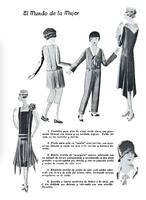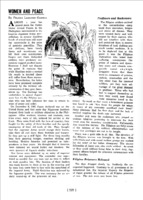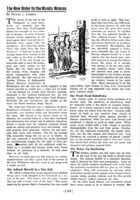The (nowadays contested) Philippine stereotype of women as pure and submissive relates directly to the figure of María Clara, the main female character in José Rizal’s Noli me Tangere. To Filipino men in the early 20th century, she could be read as the construction of the Filipino woman. This stereotype was however contested at the time by female writers such as Paz Mendoza Guazón (Villaescusa 2022, 245). Later critics, such as Mina Roces, have described the figure of María Clara as being “isolated from knowledge of politics and kept in the domestic sphere. She is a beauty in form and a Catholic saint in action” (Roces 2004, 26). María Claras were seen as the “moral guardians” of the community and had the responsibility of raising and educating young children. This representation of women originated from a novel, but magazines also served as a place in which this representation would be upheld or questioned and changed.
Women in magazines were always portrayed as being “attractive” (Mitchell 1998, 252), and there was a clear construction of women as a “beauty queen”, “the acceptable traditional definition of women in the public sphere” (Roces 2002, 161). To be a beauty queen was considered to be feminine. This can be seen through the covers of the magazines, the pictures of the well-groomed and beautiful women, but also through the types of advertisements that were printed. Not only were there pages dedicated to women’s fashion and products, but also most ads were addressed to women because it was assumed that it was their task to purchase household and cooking items and appliances for the home (Encanto 2004, 19).
However, as women started to become leaders in the public areas where they were being accepted, they started to challenge and reinvent “the Filipino woman”. There started to appear articles on whether beauty was the most important quality of women and the number of the articles highlighting women’s civic or professional work increased, especially in women’s magazines. Encanto agrees when she states that women’s magazines “served as a venue for the ‘battle over the representations of women’ by publishing articles that featured women’s concerns beyond the domestic sphere – i.e., articles that focused on civic concerns and events, successful women in the professions, legal and business advice” (Encanto 2004, 21-22). For example, the magazines The Woman’s Outlook and The Woman’s Home Journal seldom featured women as beauty queens, and they chose to focus on, for example, women’s firsts, acknowledging their accomplishments and published articles that were not solely dedicated to the latest gossip, insights in female-male relationships, fashion and beauty (Roces 2004, 32). It was through these magazines that women were given the possibility to create a new representation of themselves, to change society’s conception of what “the Filipino woman” should be and do.
Moreover, according to Cynthia Ruth Rivera, “success in women’s struggles, particularly in the political realm, is moored in women’s articulations in written form and in the publication of speeches and personal narratives” (Rivera 2004, 1). Thus, newspapers played an essential role in women’s fight for suffragism. In the previous section, “Suffragism”, we have mentioned a particular article in which women motivated other women to go and vote for their rights and to participate in the activities organized by women’s clubs. After receiving this right, there was an emergence of articles that included women in political matters, such as an article from 1943 titled “Women and Peace” that represented women as having an impact on the future of the country because of their power to persuade their husbands to stop with the rebellion against the Japanese at the start of the Japanese occupation.
Aside from this type of articles, there were also articles that focused on the woman’s experience of current events. An example is this article that describes how families, but especially women, are dealing with the economic situation the country experienced after the Japanese invasion of The Philippines.
Bibliographic references
Encanto, Georgina R. 2004. “Women’s Magazines in English from 1920 to 1972: Instruments of American Hegemony.” Plaridel 1 (1): 15-30.
Mitchell, Carol L. 1998. “The New Asian Woman: Women’s Magazines and the Spread of Mass-Culture in Southeast Asia.” The Serials Librarian 35 (1-2): 247-259.
Rivera, Cynthia Luz. 2004. “Filipino Women’s Magazines 1909-1940: Resistance, Cultural Subversion, and Compromise.” Plaridel 1 (2) : 1-20.
Roces, Mina. 2002. “Women in Philippine Politics and Society.” In Mixed Blessing: The Impact of the American Colonial Experience on Politics and Society in the Philippines, edited by Hazel M. McFerson, 159-190. Greenwood Press.
Roces, Mina. 2004. “Is the suffragist an American colonial construct? Defining the ‘Filipino woman’ in colonial Philippines.” In Women’s Suffrage in Asia. Gender, nationalism and democracy, edited by Louise Edwards and Mina Roces, 24-58. RoutledgeCurzon.
Villaescusa, Irene. 2022. “Mujer modelo y modelos de mujer: el discurso femenino y feminista en la modernidad hispanofilipina.” El desafío de la modernidad en la literatura hispanofilipina (1885-1935) Edited by Rocío Ortuño and Axel Gasquet. Leiden: Brill, 235-255.




